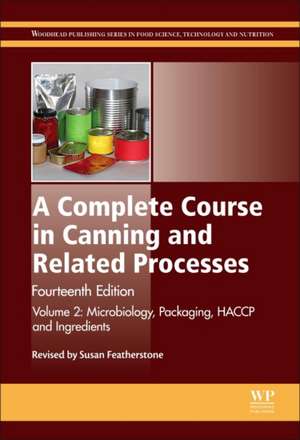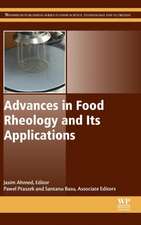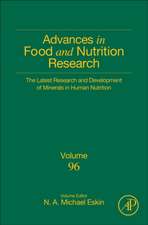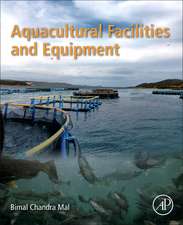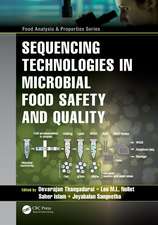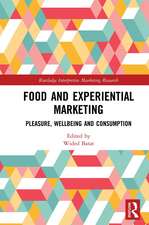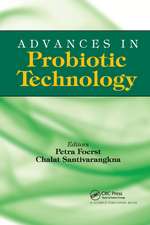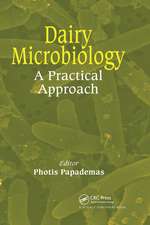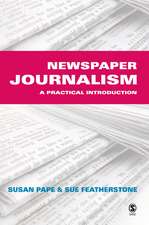A Complete Course in Canning and Related Processes: Volume 2: Microbiology, Packaging, HACCP and Ingredients: Woodhead Publishing Series in Food Science, Technology and Nutrition
Editat de Susan Featherstoneen Limba Engleză Hardback – 7 dec 2014
| Toate formatele și edițiile | Preț | Express |
|---|---|---|
| Hardback (3) | 949.18 lei 5-7 săpt. | |
| ELSEVIER SCIENCE – 7 dec 2014 | 949.18 lei 5-7 săpt. | |
| ELSEVIER SCIENCE – 5 feb 2015 | 1006.66 lei 5-7 săpt. | |
| ELSEVIER SCIENCE – 4 sep 2015 | 1011.07 lei 5-7 săpt. |
Din seria Woodhead Publishing Series in Food Science, Technology and Nutrition
- 15%
 Preț: 391.19 lei
Preț: 391.19 lei - 24%
 Preț: 1210.03 lei
Preț: 1210.03 lei - 24%
 Preț: 946.43 lei
Preț: 946.43 lei - 24%
 Preț: 960.56 lei
Preț: 960.56 lei - 23%
 Preț: 1419.50 lei
Preț: 1419.50 lei - 9%
 Preț: 1205.99 lei
Preț: 1205.99 lei - 24%
 Preț: 1189.10 lei
Preț: 1189.10 lei - 9%
 Preț: 1006.66 lei
Preț: 1006.66 lei - 9%
 Preț: 984.09 lei
Preț: 984.09 lei - 9%
 Preț: 1206.85 lei
Preț: 1206.85 lei - 24%
 Preț: 1081.43 lei
Preț: 1081.43 lei - 24%
 Preț: 1185.22 lei
Preț: 1185.22 lei - 9%
 Preț: 922.07 lei
Preț: 922.07 lei - 24%
 Preț: 1192.22 lei
Preț: 1192.22 lei - 9%
 Preț: 1215.75 lei
Preț: 1215.75 lei - 24%
 Preț: 1162.37 lei
Preț: 1162.37 lei - 9%
 Preț: 950.09 lei
Preț: 950.09 lei - 24%
 Preț: 1162.62 lei
Preț: 1162.62 lei - 24%
 Preț: 801.31 lei
Preț: 801.31 lei - 27%
 Preț: 379.84 lei
Preț: 379.84 lei - 29%
 Preț: 1336.07 lei
Preț: 1336.07 lei - 24%
 Preț: 798.74 lei
Preț: 798.74 lei - 24%
 Preț: 1333.02 lei
Preț: 1333.02 lei - 9%
 Preț: 1018.93 lei
Preț: 1018.93 lei - 31%
 Preț: 922.77 lei
Preț: 922.77 lei - 9%
 Preț: 1045.58 lei
Preț: 1045.58 lei - 24%
 Preț: 1131.77 lei
Preț: 1131.77 lei - 23%
 Preț: 1635.83 lei
Preț: 1635.83 lei - 9%
 Preț: 1277.62 lei
Preț: 1277.62 lei - 24%
 Preț: 1049.04 lei
Preț: 1049.04 lei - 24%
 Preț: 1134.60 lei
Preț: 1134.60 lei - 9%
 Preț: 1076.36 lei
Preț: 1076.36 lei - 24%
 Preț: 1158.21 lei
Preț: 1158.21 lei - 9%
 Preț: 1065.06 lei
Preț: 1065.06 lei - 9%
 Preț: 1067.39 lei
Preț: 1067.39 lei - 24%
 Preț: 812.03 lei
Preț: 812.03 lei - 9%
 Preț: 1203.13 lei
Preț: 1203.13 lei - 23%
 Preț: 1237.19 lei
Preț: 1237.19 lei - 24%
 Preț: 948.79 lei
Preț: 948.79 lei - 23%
 Preț: 1138.06 lei
Preț: 1138.06 lei - 9%
 Preț: 868.43 lei
Preț: 868.43 lei - 24%
 Preț: 871.98 lei
Preț: 871.98 lei - 20%
 Preț: 1272.59 lei
Preț: 1272.59 lei - 29%
 Preț: 1195.06 lei
Preț: 1195.06 lei - 9%
 Preț: 1002.45 lei
Preț: 1002.45 lei - 9%
 Preț: 505.72 lei
Preț: 505.72 lei - 9%
 Preț: 1062.13 lei
Preț: 1062.13 lei - 24%
 Preț: 1306.94 lei
Preț: 1306.94 lei
Preț: 949.18 lei
Preț vechi: 1242.38 lei
-24% Nou
Puncte Express: 1424
Preț estimativ în valută:
181.65€ • 186.02$ • 151.10£
181.65€ • 186.02$ • 151.10£
Carte tipărită la comandă
Livrare economică 12-26 martie
Preluare comenzi: 021 569.72.76
Specificații
ISBN-13: 9780857096784
ISBN-10: 0857096788
Pagini: 376
Dimensiuni: 152 x 229 mm
Ediția:14
Editura: ELSEVIER SCIENCE
Seria Woodhead Publishing Series in Food Science, Technology and Nutrition
ISBN-10: 0857096788
Pagini: 376
Dimensiuni: 152 x 229 mm
Ediția:14
Editura: ELSEVIER SCIENCE
Seria Woodhead Publishing Series in Food Science, Technology and Nutrition
Public țintă
R&D professionals and quality assurance/quality control professionals in the canning industry; food microbiologists and engineers with an interest in thermal processing; academics working in this fieldCuprins
- Related titles
- Woodhead Publishing Series in Food Science, Technology and Nutrition
- Preface
- Introduction
- Part One. Microbiological hazards and process control
- 1. Microbiology of canned foods
- 1.1. Introduction
- 1.2. Key micro-organisms in food microbiology
- 1.3. Controlling the growth of micro-organisms
- 1.4. Important fungi in the food industry
- 1.5. Important bacteria in the food industry
- 1.6. Botulism
- 2. Spoilage of canned foods
- 2.1. Introduction
- 2.2. Types of spoilage of canned foods
- 2.3. Sources of contamination
- 2.4. Spoilage of canned vegetables
- 2.5. Microbiological standards for ingredients
- 3. Heat penetration determinations and thermal process calculations
- 3.1. Introduction
- 3.2. pH classification of canned foods
- 3.3. Thermal death time
- 3.4. HTST processing
- 3.5. Inoculated pack studies
- 3.6. HP determinations
- 3.7. Process establishment methods
- 3.8. Process calculation methods
- 3.9. Some causes of unreliable heat penetration data
- 3.10. HTST: a special type of heat penetration test
- 3.11. Summary
- 4. Optimising retort operations for canned goods
- 4.1. Introduction
- 4.2. Optimising the thermal process to reduce overprocessing
- 4.3. Changing the processing regime from low-acid sterilisation to pasteurisation
- 4.4. New thermal technologies
- 4.5. Converting batch processes to continuous processing
- 4.6. Summary
- 1. Microbiology of canned foods
- Part Two. Containers and ingredients
- 5. Metal containers for canned foods
- 5.1. Introduction
- 5.2. Types of cans
- 5.3. Can manufacture
- 5.4. Can lacquers
- 5.5. Tinplate can corrosion
- 5.6. Corrosion attributable to canning practices
- 5.7. Corrosion attributable to storage conditions
- 5.8. Can seam inspection
- 5.9. Storage and shipping of cans
- 5.10. Aluminium cans
- 5.11. Conclusion
- 6. Glass and plastic containers for canned foods
- 6.1. Introduction
- 6.2. Vacuum closures for glass – general characteristics
- 6.3. Factors effecting vacuum formation
- 6.4. ‘Cold-water vacuum check’ method
- 6.5. Vacuum closure application for glass containers
- 6.6. Auxiliary equipment
- 6.7. Closures for glass containers
- 6.8. Vacuum sealing
- 6.9. Coding
- 6.10. Processing glass containers
- 6.11. Packaging of food in plastic containers
- 6.12. Food contact and migration
- 6.13. Choice of plastic container
- 6.14. Sealing techniques
- 6.15. Warehousing and transportation
- 6.16. Plastic package recycle potential
- 6.17. Conclusion
- 7. Retortable flexible containers for food packaging
- 7.1. Introduction
- 7.2. Structure of flexible containers
- 7.3. Retort pouch manufacture
- 7.4. Quality assurance in retort pouch manufacture
- 7.5. Filling
- 7.6. Sealing
- 7.7. Processing/sterilization
- 7.8. Quality control tests for pouch laminate, pouch, and semirigid containers
- 7.9. Advantages of using retortable flexible containers
- 7.10. The disadvantages of flexible containers
- 8. Ingredients used in the preparation of canned foods
- 8.1. Introduction
- 8.2. Food additives
- 8.3. Salt, salt tablets, and combination tablets in canning
- 8.4. Carbohydrates in canning and preserving
- 8.5. Spices, essential oils, and oleoresins
- 8.5.2. Essential oils and oleoresins
- 8.6. Textured vegetable proteins
- 8.7. Monosodium glutamate
- 8.8. Water-soluble gums (hydrocolloids)
- 8.9. Emulsifiers (surfactants)
- 8.10. Colour additives
- 8.11. Preservatives
- 8.12. Acidulants
- 8.13. Firming agents
- 8.14. Alternative sweeteners and fat replacers
- 5. Metal containers for canned foods
- Part Three. Safety and quality
- 9. Hazard analysis and critical control point (HACCP) systems in food canning
- 9.1. Introduction
- 9.2. The NACMCF summary of the HACCP system
- Appendix A. Examples of questions to be considered in a hazard analysis
- Appendix B (N.B. Appendix B was extracted from Committee’s November 1989 HACCP document.)
- Appendix C
- Appendix D. Examples of HACCP records
- Appendix E. Examples of verification activities
- 10. In-plant quality control in food canning operations
- 10.1. Introduction
- 10.2. Quality control department
- 10.3. Control of factory operations
- 10.4. Examination of line samples
- 10.5. Examination of water
- 10.6. Testing canned foods
- 10.7. Purchasing raw products for canning
- 10.8. The past and future of quality control
- 11. Dealing with consumer complaints and market recalls in food canning
- 11.1. Introduction
- 11.2. Recording complaints
- 11.3. Responding to complaints
- 11.4. Product tampering
- 11.5. Traceability
- 11.6. Product recalls
- 11.7. Sample forms
- 9. Hazard analysis and critical control point (HACCP) systems in food canning
- Appendix
- Glossary
- Index
Recenzii
"This major new edition continues the esteemed reputation of the title, with extensively revised and expanded coverage. The book remains a key technical reference for R&D managers within the food industry, product researchers and academics alike." --FST Magazine
